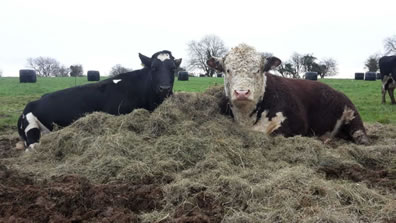Don’t invest unless you’re prepared to lose all the money you invest. This is a high - risk investment and you are unlikely to be protected if something goes wrong. Take 2 mins to learn more

investing
Working with the soil to tackle climate change
Working ith the soil to tackle climate change, how regenerative farming methods are keeping harmful carbon emissions from the atmosphere.
At the first signs of spring, many people will be heading back to their gardens or allotments to begin preparations for the warmer seasons to come. At the heart of the preparations is the soil. Whether we’re weeding or digging or feeding it with nutrients to ensure a great crop, we’re aware of the importance of good soil. But when we think about soil, we don’t usually consider it to be one of the most crucial elements in the fight against climate change, yet it has the potential to be.
With the right treatment, the soil can draw in and store carbon, keeping it out of the atmosphere where it can contribute to global warming. In fact, the soil has the potential to store more carbon than the atmosphere and all of the forests and plants in the world combined, making it a pretty powerful weapon in the fight against climate change!
The problem with food production
There is little doubt that modern, mass farming methods are one of the key contributors to greenhouse gas emissions and it’s universally accepted that we need to rethink the way we farm if we are to turn back the tide of climate change. From overuse of land and water to emissions from intensively managed livestock, agriculture has a key part to play in creating harmful emissions.
The world’s soils contain about 3,500 billion tons of carbon and conventional industrial farming methods release CO2 from the soil into the atmosphere. These methods are doubly damaging because they also use fossil fuels in the creation and application of fertilisers and pesticides, and then unnaturally accelerate the life cycles of the soil and animals which releases yet more greenhouse gases.
A better way of farming
Luckily, not all farms are the same. And while the need for farmed produce exists, we look to a new generation of farmers to pioneer a better way to bring it to market. The current industrial agriculture sector might be successful in producing large amounts of food, but the problems it creates for the land, ecosystems and the environment outweigh the benefits that mass-produced food brings.
Many of us are familiar with the term Organic Farming, but in recent years, the practice of Regenerative Farming has gathered support from farmers and environmentalists alike as a way to keep carbon in the soil and restore soil fertility and biodiversity. Last year, Prince Charles said the UK needed a 'Rapid transition to regenerative farming' and it’s a concept that is gaining momentum.
What is regenerative farming?
Without going into too much technical detail, farmers who practice the regenerative farming method look at the entire farm as one ecosystem and rather than simply taking what the earth offers, they look to respect and nurture every element. So, in the case of the soil, it’s avoiding harmful pesticides and ensuring it is as healthy and resilient as it can be.
One small dairy farm that has regenerative farming practices at the heart of what it does is Stroud Micro Dairy. The team there is committed to using only environmentally friendly practices as much as possible to produce the raw milk and dairy products that they provide to the local community in Stroud.
Proudly plastic-free, Stroud Micro Dairy believes that a happy herd makes for better dairy produce, so they treat their cows with care and respect. They have pioneered the ‘calf at foot’ system, where calves are not taken away from their mothers at birth, as with other dairy farms, but remain with them for three months.
Working with nature
The passionate team at Stroud Micro Dairy are inspired by permaculture, biodynamics and organic farming, and bring all these ideas together to create a farm that has a positive regenerative effect on the land and local environment. Their ethos is to ‘Do more good rather than less bad’.
Through their regenerative farming methods, they not only protect the soil and enable it to retain more carbon but encourage biodiversity meaning the local wildlife benefits too. Local people also reap the rewards and the farm has a growing demand for their raw milk (meaning it does not go through the pasteurisation process, so retains all its natural vitamins, proteins, essential fatty acids, digestive enzymes and minerals.), kefir and yoghurt.
A community-owned farm
Stroud Micro Dairy are currently running a share offer to bring the dairy farm into community ownership, meaning investors can become part-owners and have a say in the future running of the farm. This will make Stroud the first dairy co-operative owned by the community in the UK! The cooperative model they are adopting sits well with the farm’s ethos and will enable the farm to become more resilient in the future.
Investments in the share offer will also enable the dairy to grow and adapt to meet the growing demand for its products while retaining its regenerative farming methods.
Be part of it
If you want to support this vision for the future of farming, you can invest in the Stroud Micro Dairy share offer from as little as £50 and investments target a return of up to 3% while giving investors a share in this pioneering dairy business.
If you are interested in learning more about the Stroud Micro Dairy share offer, you can watch a recording of a recent webinar where Kees Frederiks, Founder discussed their plans for the future. You can get more information and invest on the Ethex platform. Please note that when investing your capital is at risk and returns are not guaranteed.

